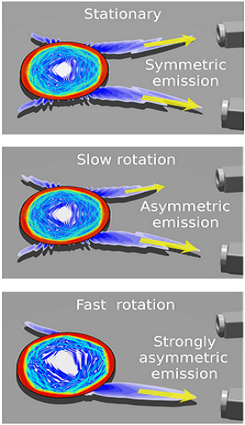New Approach Could Develop World's Smallest Optical Gyroscope
Gyroscopes are the devices that are mainly used for measuring or maintaining orientation. They are absolutely essential components in a number of technologies such as inertial guidance systems (for monitoring motion and orientation of an object), manned or unmanned aerial vehicles such as space probes, satellites, radio-controlled helicopters, rockets and many more. With a vision of developing exceptionally compact gyroscope-based navigation systems along with other intriguing applications, a team of applied physicists has devised a technique for developing the world's smallest optical gyroscope. By using this new detection scheme, a light-powered gyroscope having size (about 10 microns) equivalent to just a fraction of the width of a human hair may be developed.

For developing the new type of optical gyroscopes, a pair light waves is forced into the optical cavity so that these waves could travel in both clockwise and anti-clockwise directions around the microscopic track. In order to control the direction of the waves, the team was required to accurately design the shape of the optical cavity. For finding the speed of rotation, the researchers balanced the light trapping properties of the cavity so that some light could escape for generating a far-field emission pattern. Due to this, they were able to measure the pattern created by the light while leaving the cavity. This method will help in maintaining the size of the cavity and sensitivity of this kind of optical gyroscopes that are based on Sagnac effect.
The results were published in the Optical Society’s (OSA) journal Optica. As presented in the paper, if the researchers are able to develop such a super-small gyroscope then it can be incorporated into optical circuit boards that use light for carrying information instead of electric currents. The research is at the nascent stage and developments are being carried out by finding different methods that can further minimize the reduction of the sensitivity to rotation owing to far-field emission patterns. The team also wants to find out whether there is a possibility that many modes or light paths are present at the same time in the cavity.
Source: #-Link-Snipped-#
For developing the new type of optical gyroscopes, a pair light waves is forced into the optical cavity so that these waves could travel in both clockwise and anti-clockwise directions around the microscopic track. In order to control the direction of the waves, the team was required to accurately design the shape of the optical cavity. For finding the speed of rotation, the researchers balanced the light trapping properties of the cavity so that some light could escape for generating a far-field emission pattern. Due to this, they were able to measure the pattern created by the light while leaving the cavity. This method will help in maintaining the size of the cavity and sensitivity of this kind of optical gyroscopes that are based on Sagnac effect.
The results were published in the Optical Society’s (OSA) journal Optica. As presented in the paper, if the researchers are able to develop such a super-small gyroscope then it can be incorporated into optical circuit boards that use light for carrying information instead of electric currents. The research is at the nascent stage and developments are being carried out by finding different methods that can further minimize the reduction of the sensitivity to rotation owing to far-field emission patterns. The team also wants to find out whether there is a possibility that many modes or light paths are present at the same time in the cavity.
Source: #-Link-Snipped-#
0
